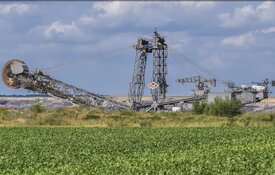The Metals Report: You just gave a speech at the Prospectors and Developers Association of Canada (PDAC) convention. What was your message for natural resource investors?
Chris Berry: My speech was called "Four Billion Consumers Can't Be Wrong, Can They?," and its message was that while global economic trends are uncertain at best, with the Euro Zone in a recession, North America exhibiting below-trend growth and much of Asia slowing, there is still a great deal of economic growth in countries throughout the world and this bodes well for the industrial and energy metals going forward.
According to Goldman Sachs, in 2011 China added $1.3 trillion to global growth. This is the equivalent of adding an economy the size of Greece to the global economy every 12.5 weeks or an economy the size of Australia over the course of the year. In 2012, if you look at all four BRIC (Brazil, Russia, India and China) economies combined, they added $2.2 trillion to global growth. This is the equivalent of one economy the size of Italy—the eighth-largest economy in the world—over the course of the year. I looked at broad economic data in the U.S., the Eurozone and China, such as industrial production, consumer spending and debt to GDP ratios, to present a vision of where we are in the economic cycle.
One of the key takeaways was to remember that the natural resources business is a cyclical one and even though many economic trends are contracting rather than expanding, now is the time to be evaluating demographics and other growth trends to position portfolios. Despite much of the pervasive doom and gloom I experienced at PDAC, I'm optimistic over the longer term when I look at the rise of the consumer class in Asia.
TMR: Were people nodding their heads? Were they skeptical?
CB: I think it was a breath of fresh air. When there's such a lack of optimism, it's a contrarian indicator to me. The overall sour tone is one of the reasons I'm so optimistic about the industrial metals space right now. Many of the junior mining companies involved in energy metals are very cheap on both a relative and absolute basis.
TMR: You're an optimistic guy, because 2012 was a pretty tough year, particularly for rare earth element (REE) investors. What are the macro trends behind that optimism?
CB: The number-one trend is a diffusion of technology. For example, there are almost as many cellular connections as people on the globe. If my research is correct, the global population is 7.1 billion (7.1B), and there are approximately 6.9B cellular connections. This is growing not just in Asia, but all over the world. How many wireless devices do you have in your home? I have six. Many people are gaining access to these technologies for the first time and for this diffusion of technology to continue, access to energy metals such as REEs is imperative. Of course, recycling and substitution must also be taken into account, but broadly speaking, attaining a higher quality of life necessitates a secure supply of energy metals like REEs.
Urbanization is another macro trend. People are transitioning from an agrarian lifestyle to an urbanized one that is more commodity intensive. Life expectancy, already high here in the West, is increasing in countries like China and India. In 1960, the average life expectancy in China was 47. Today that life expectancy is 73. This is 26 years of additional consumption spread across tens of millions of people. In India, in 1960, life expectancy was 42. Today it is 64. With people living longer, healthier lives, you can really begin to get a sense of how consumer purchasing power is set to multiply in coming years. This has profound implications for energy metals.
TMR: What will determine which REE companies make it and which don't?
CB: I don't think there's a boilerplate list of what it takes for a REE exploration company to advance from exploration to development to production. It involves several different factors. When we evaluate companies, we typically use our Ten Point Factor Model. Today, we're most concerned with financial sustainability—cash. Does the REE junior in question have adequate cash on the balance sheet to last through this tough financing environment? In addition to that, we focus on management experience in the REE supply chain, the metallurgy of the deposit and the geographic location. REEs still retain their strategic importance for both industrial and defense technologies, so we are partial to deposits in reliable geopolitical jurisdictions. Resource nationalism is spreading across the globe as more governments realize the importance of domestic natural resource supply chains and the jobs and tax revenues they can generate. We expect this to continue.
As you mentioned in your question, there is still a glut of REE juniors in existence today—even taking into account the most optimistic future demand forecasts. The slow purge in this space will continue until equilibrium is reached.
TMR: How much room is there for REE companies, either producing light or heavy elements, to be successful?
CB: Forecasting supply and demand for REEs as a whole is very difficult and it is important to remember that there are 17 of them, each with different supply and demand dynamics and end markets. Certain rare earth oxides (REOs) will drive revenue more than others. The focus and higher value is currently placed on the heavy rare earths (HREEs), and most of the future successful projects will focus there. We follow a couple in particular, Tasman Metals Ltd. (TSM:TSX.V; TAS:NYSE.MKT; TASXF:OTCPK; T61:FSE) and Ucore Rare Metals Inc. (UCU:TSX.V; UURAF:OTCQX).
Tasman now has two HREE deposits in Sweden, both of which are NI 43-101 compliant. The Olserum project has an Indicated resource of 4.5 million tonnes (4.5 Mt) at .6% total rare earth oxides (TREO) and an Inferred resource of 3.3 Mt at .63% TREO, all at a .4% TREO cutoff. The company tells me that the five critical REEs comprise up to 40% of the REE content in the deposit. The mineralogy is characterized by xenotime and monazite, which are well known from a processing standpoint.
Tasman's other resource is Nora Kärr, which at a .4% cutoff shows an Inferred total of 60.5 Mt at .54% TREO. The mineralogy is characterized by eudialyte, which I am told is relatively straightforward from a processing standpoint. A preliminary economic assessment (PEA) has been published on Nora Kärr and indicated a capital expenditure of $290M, which includes a $66M contingency. As far as REE projects go, this is a very manageable number.
The company continues to be managed well, and its infrastructure is sound—one of the main reasons for the relatively low capex, in my opinion. It's the only NI-43-101-qualified resource in the entire European Union. In this case, I think many are overlooking an incredibly strategic company and asset. I could easily see a European automaker like BMW taking an interest in the company due to its proximity to European population and the quality of its assets, which could be integrated into a global supply chain.
TMR: Are there any catalysts coming up other than that report?
CB: One catalyst is to push forward with the environmental permitting. In addition to this, the company will continue to optimize the metallurgy and recovery rates at Nora Kärr.
TMR: What are the catalysts for Ucore?
CB: Ucore is going to leverage technology to optimize economics at Bokan Mountain. Specifically, the company will use its solid phase extraction technology on site to lower overall costs. Essentially, this technology removes impurities like uranium or thorium before producing a REE concentrate. The end result is a more valuable end product.
With explicit support from both state and federal authorities, Ucore will push forward with permitting in 2013. Alaskan U.S. Senators Murkowski and Begich recently introduced a bill in the U.S. Senate to expedite infrastructure development and the Alaskan state Senate introduced a resolution to expedite permit issuance. Introduction of these bills is no panacea, but it a strong signal to me that our legislators are realizing the potential of Bokan Mountain.
The PEA the company released in late 2012 demonstrated the economic potential for a mine and of particular significance was the low capex number of $221M, which includes a $25M contingency. This is among the lowest of the potential capex numbers I have seen for a REE project.
Ucore's strategic significance is also underappreciated by the marketplace. It is still the largest predominately HREE deposit on U.S. soil with heavy rare earth oxide content of 39% of TREO. A recovery in REE prices will only help the economics here.
With REE plays, the absolute size of the deposit isn't the most important factor to me. When I look at a deposit, I ask myself, Does this company have what the market wants? Both Tasman and Ucore do, and I think they're trading at discounts relative to their true values.
With respect to HREEs, the REE junior exploration space is still very much an open race to be first to production.
TMR: The last time we talked you mentioned Medallion Resources Ltd. (MDL:TSX.V; MLLOF:OTCQX; MRD:FSE). You said the most important factor there was management. The company has hired some new team members since then. What's your assessment?
CB: Medallion is not going to be a REE mining operation in the traditional sense. The company plans to process monazite from heavy mineral sands to produce separated REOs. Medallion's management team has the technical expertise to see this business model through. There are several catalysts here, including reaching agreements on the ideal jurisdiction to build a plant and procuring monazite feed stocks. It's a totally different take on the REE space—one that could be achieved at low overall costs. I appreciate it, and I'm interested to see it move forward.
TMR: Great Western Minerals Group Ltd. (GWG:TSX.V; GWMGF:OTCQX) recently started the production of its REE alloy strip-casting furnace and it has customers in China. Does that fit your theme of "cash flow is king"?
CB: As just about every junior mining company is reliant on the capital markets for its existence, anytime a company can generate cash flow to plow back into the business and defray dilution, it is a net positive. Great Western Minerals is awaiting the receipt of a second strip-casting furnace that will increase alloy output and add to the revenue stream. This is a welcome step in the company's plan to establish an integrated REE supply chain outside of China. With newly installed management, the next catalyst will be a PEA on Steenkampskraal, which the market has been waiting for.
Another REE company I am following is a neighbor of Great Western's, Frontier Rare Earths Ltd. (FRO:TSX). We just met with company management at PDAC and the takeaway was that this is a REE company that the overall market is overlooking. Frontier is developing the Zandkopsdrift REE deposit in western South Africa. The company has $52M on its balance sheet and is funded through a bankable feasibility study. I don't know of too many other companies in this space that can make that same claim.
From a strategic standpoint, Frontier has a definitive agreement with KORES, the entity run by the Korean government, with the mandate of establishing Korea's access to critical and strategic minerals. I have seen KORES in a number of deals, most recently in the lithium space. KORES has called development of Zandkopsdrift a "strategic priority" and took a 10% interest in the project for $24M. I am not aware of another REE junior that has a deal like this in place that can lead to offtake agreements or additional financing when the decision to build a mine comes closer.
A PEA has been completed on Zandkopsdrift and while the forecast capex here is higher than some of its competitors at over $900M, this includes its own separation plant, sulphuric acid plant, concentrator plant and associated infrastructure. The company tells me that the critical REOs (neodymium, europium, terbium, dysprosium and yttrium) will only account for roughly 20% of production volume, but will account for roughly 70% of revenues. This is what I mean when I said earlier you must understand how a REE company will generate revenue. Frontier is positioning itself well.
TMR: You said you're positive about graphite. Are you counting on emerging countries to fuel the next leg in this super cycle?
CB: I am. There's been a lot of ink over the past 18 months about the commodity super cycle being over. I believe the commodity super cycle is still alive –but its complexion is changing. Instead of being driven solely by infrastructure, it's now becoming increasingly focused on the consumer. Graphite's uses are ubiquitous, from current-day uses in steel production, crucibles and refractories to next-generation uses in battery technologies and fuel cells. Graphite has a critical role to play in multiple industries and I anticipate this continuing, implying steady graphite demand going forward.
One of the reasons I like graphite more than some energy metals is because a supply chain outside of China exists for end products developed using graphite. This is very different from the REE story we are all well aware of. Globally, 70–75% of graphite is produced in China, but the downstream processes take place in other parts of the world. Graphite is a fragmented and complicated industry, but I think this provides opportunities for a small number of new entrants. Consolidation of graphite mining in China is another factor that should continue to give those non-Chinese graphite explorers an opportunity.
TMR: But what if the housing news out of China is true and things are slowing down there? What does that do to your thesis?
CB: In the long run, nothing. The trajectory of housing prices in China indicates an overheating economy and the perpetual threat of an economic hard landing does exist. Ultimately, the Chinese leadership must put policy measures in place to make economic growth less dependent on investment and more dependent on consumer spending—sort of the mirror opposite of what needs to happen in the United States.
The leadership in China is focusing on a 7–7.5% GDP growth rate. For a clearer, more accurate picture, I look at metrics that are more difficult to manipulate. Some of those include electricity usage in China, freight and rail haulage and bank loan issuance. I think the country is growing closer to 5–5.5% when I look at these types of metrics. To be clear, I am not alarmed by this. Despite the slower growth rate, the Chinese economy is much larger today than it was when it was growing at a higher GDP growth rate. A slower growth rate is more realistic and more sustainable but again, the complexion of that growth must continue to change.
TMR: Once graphite demand and prices head up again, what companies could take advantage of the opportunity?
CB: I'm tracking over 80 publicly traded junior mining graphite companies today. There are also a smaller number of privately held companies. The overwhelming number of these companies will not survive due to a lack of availability of financing and a realization that graphite is a relationship business and it can take a great deal of time to foster the trust necessary to integrate into an end user's supply chain. This will resemble the "slow purge" I referenced with respect to REEs, but will happen faster. Twelve of the companies I am tracking have an NI-43-101 or JORC-compliant resource. Three of them have had PEAs done. Only one has a bankable feasibility study. So set against the backdrop of dozens of graphite hopefuls, you can see that very few of them know anything about their deposits or have a realistic chance of breaking into the space. There are, however, a handful of graphite exploration companies that are earlier stage, that are developing into interesting stories.
Some of the advanced plays include Northern Graphite Corporation (NGC:TSX.V; NGPHF:OTCQX), Focus Graphite Inc. (FMS:TSX.V) and Flinders Resources Ltd. (FDR:TSX.V).
TMR: Northern Graphite is starting its Bissett Creek project in Ontario this year. Where is it in the continuum of companies in the race?
CB: Northern Graphite is still the leader in the junior mining graphite space, in my opinion. I say this because it has published a bankable feasibility study and so we can get a clearer picture of the economics associated with a potential mine and what products the company intends to produce. We can argue about grade, purity and flake size, but company management has consistently delivered and this breeds confidence. Recent news from the company regarding results from a drill program effectively increased the overall grade of its deposit, and it moved the stock up nicely.
The next catalysts for the company include an update to the bankable feasibility study, which should improve the economics and discussions with strategic partners.
TMR: You also mentioned Flinders. What do you like about it?
CB: Flinders shares similarities with Tasman, including some crossover with management and a location in Sweden. Again, the strategic significance of a natural graphite mine in Europe that could feed a number of industries is something to remember. We know a great deal about the company's past-producing Woxna deposit, including the "footprint," or flake size distribution. The next catalysts for the company will be the release of a PEA in July, which will take into account the company's process of graphite production for a 20,000 tons per year operation (up from 13,000 tons per year) as well as additional metallurgical data, which looks promising.
TMR: And Focus?
CB: Focus has attacked the junior graphite market from a different angle than its peers. It's not just focused on developing Lac Knife, its flagship deposit in Québec, but on integrating high-purity graphite from the mine with graphene development. We know a great deal about Lac Knife at this point and the company will undertake a two-phase drill program this summer to further the understanding and size of the deposit. Lac Knife is one of the highest-grade graphite deposits in the world, so increasing tonnage can enhance project economics. Another catalyst will be any news on offtake or strategic partners this year.
TMR: Is Energizer Resources Inc. (EGZ:TSX.V; ENZR:OTCBB) on your list of companies to watch?
CB: Energizer is currently focused on its Molo graphite deposit in Madagascar and has achieved several milestones over the past year. The company released an NI 43-101 resource report showing an extremely large deposit with significant grades, including an Indicated total of 83 Mt at 6.36% Cg and an Inferred total of 40 Mt at 6.3% Cg. A PEA was also recently published, which used relatively conservative numbers. The company has a number of partnerships in place that can help navigate the path to production. Overall, Energizer has done a great deal of work in a relatively short period of time. At first glance, the economics look promising. Now the company needs to refine them and think about the next challenges, namely offtakes and financing.
TMR: Your final takeaway at a presentation you gave in January was that the commodity super cycle is intact but that the traditional engines of growth are changing. What does that mean for investors?
CB: The economies in the BRICs are slowing. However you look at it, growth is not what it once was and this is undeniable. I encourage investors to broaden the net. Rather than just focus on these four economic juggernauts, take a look at some of the other economies that have favorable demographic profiles, a large and growing middle class and a relatively diversified economy. I am studying consumption trends in countries like Turkey, Indonesia, Mexico and Colombia. They have smaller populations than the BRIC countries, but they're growing and coupled with the BRICs and other emerging markets, I think a rather interesting long-term growth story emerges. Don't doubt the resolve of a poor, hungry and driven individual who wants a better quality of life for themselves or their families.
This is where the super cycle is changing its complexion. Hundreds of millions of people in these countries are starting to urbanize. The inference here is that a higher quality of life is one that is more commodity-intensive. This won't happen overnight but I think a focus on how energy metals and demographics work together is a sound wealth creation strategy.
TMR: Thanks for sharing your ideas, Chris.
CB: Thanks for having me.
With a lifelong interest in geopolitics and the financial issues that emerge from these relationships, Chris Berry founded House Mountain Partners in 2010. The firm focuses on the evolving geopolitical relationship between emerging and developed economies, the commodity space, and junior mining and resource stocks positioned to benefit from this phenomenon. Chris holds an MBA in finance with an international focus from Fordham University and a BA in international studies from the Virginia Military Institute. He co-authors a free newsletter you can subscribe to at www.discoveryinvesting.com.
Want to read more Metals Report interviews like this? Sign up for our free e-newsletter, and you'll learn when new articles have been published. To see a list of recent interviews with industry analysts and commentators, visit our Metals Report homepage.
DISCLOSURE:
1) JT Long conducted this interview for The Metals Report and provides services to The Metals Report as an employee. She or her family own shares of the following companies mentioned in this interview: None.
2) The following companies mentioned in the interview are sponsors of The Metals Report: Frontier Rare Earths Ltd., Tasman Metals Ltd., Medallion Resources Ltd., Great Western Minerals Group Ltd., Northern Graphite Corporation and Energizer Resources Inc. Streetwise Reports does not accept stock in exchange for its services or as sponsorship payment.
3) Chris Berry: I or my family own shares of the following companies mentioned in this interview: Northern Graphite Corporation. I personally am or my family is paid by the following companies mentioned in this interview: None. My company has a financial relationship with the following companies mentioned in this interview: Ucore Rare Metals Inc. I was not paid by Streetwise Reports for participating in this interview. Comments and opinions expressed are my own comments and opinions. I had the opportunity to review the interview for accuracy as of the date of the interview and am responsible for the content of the interview.
4) Interviews are edited for clarity. Streetwise Reports does not make editorial comments or change experts' statements without their consent.
5) The interview does not constitute investment advice. Each reader is encouraged to consult with his or her individual financial professional and any action a reader takes as a result of information presented here is his or her own responsibility. By opening this page, each reader accepts and agrees to Streetwise Reports' terms of use and full legal disclaimer.
6) From time to time, Streetwise Reports LLC and its directors, officers, employees or members of their families, as well as persons interviewed for articles and interviews on the site, may have a long or short position in securities mentioned and may make purchases and/or sales of those securities in the open market or otherwise.










































